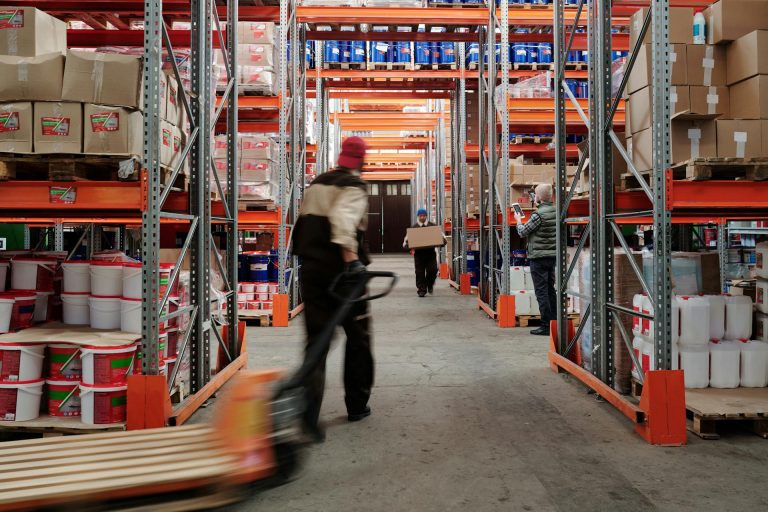If you’re running a business with manufacturing and warehousing needs, you’ve probably realized by now that your warehouse space can make or break your operations. It’s not just about having a big room to store stuff – it’s about creating an efficient, cost-effective hub that keeps your business running smoothly.
Let’s discuss how to choose the perfect warehouse space for your growing business, and set up expectations which will keep you focused on long-term success.
How Warehouses Impact Your Business
Let’s start with the basics: why does your warehouse matter so much? Your warehouse is the heart of your operations, receiving and distributing essential “supplies” that are required to continue operating. A well-functioning warehouse keeps everything pumping along nicely, while a mis-managed one can cause all sorts of blockages in your business.
Efficiency is the name of the game here. A good warehouse setup means you can quickly locate, pick, pack, and ship products. This speed translates directly into happy customers who receive their orders promptly. On the flip side, a disorganized warehouse can lead to delays, errors, and frustrated customers.
Then there’s the cost factor. Your warehouse represents a significant investment, both in terms of real estate and inventory. An efficient warehouse helps you minimize carrying costs, reduce waste, and make the most of your space.
But perhaps most importantly, your warehouse plays a crucial role in your ability to grow. A well-planned warehouse gives you the flexibility to scale up operations as your business expands. It’s all about finding that sweet spot between your current needs and your future ambitions.
Pick a “Brain” for the Warehouse
Now, let’s talk tech. Given all the digital offerings available, your warehouse is only as good as the Inventory Management System you’re using. Think of it as the brain of your operation, keeping track of every item, monitoring stock levels, and helping you make smart decisions about ordering and storage.
When choosing an inventory management system, look for features like real-time tracking, integration with your e-commerce platforms, and robust reporting capabilities. The right system will give you a bird’s-eye view of your entire inventory, helping you avoid overstocking or stockouts.
But here’s the kicker: your inventory management system needs to work hand-in-hand with your physical warehouse setup. It’s not just about having fancy software – it’s about creating a system where your digital tools and your physical space are in-sync.
For small and medium businesses, we recommend cloud-based inventory management solutions. They’re typically more affordable and scalable than traditional on-premise systems. Plus, they allow you to access your inventory data from anywhere, which is super handy when you’re wearing multiple hats in your business.
How Location Matters
When it comes to warehouses, location isn’t just about real estate – it’s about strategy. Your warehouse’s location can significantly impact your operational costs and efficiency.
First, consider your proximity to suppliers and customers. The closer you are to both, the lower your transportation costs will be. This is especially crucial if you’re dealing with time-sensitive or perishable goods.
Next, think about the local infrastructure. Is the area well-served by highways, railways, or ports? Easy access to transportation networks can speed up your shipping times and reduce logistics costs.
Don’t forget about the local labor market. You’ll need skilled workers to run your warehouse efficiently. Is the area you’re considering known for its logistics expertise? Are there training programs or schools nearby that produce qualified candidates?
Finally, take a look at local regulations and taxes. Some areas offer incentives for businesses in certain industries, which could translate into significant savings for you.
Having Enough Space to Work Without Starting Too Small
One of the biggest mistakes we see small businesses make is underestimating their space needs. It’s tempting to go for a smaller, cheaper warehouse when you’re just starting out, but will it accommodate your business needs for the next 3-5 years?
Start by assessing your current space needs. How much inventory do you typically carry? What about seasonal fluctuations? Then, factor in your growth projections. Where do you see your business in 3-5 years?
The risks of undersizing your warehouse are real. You might find yourself cramped for space during busy periods, unable to take advantage of bulk purchasing discounts, or forced to turn down orders because you can’t store enough inventory.
That said, we’re not suggesting you rent out a massive warehouse right off the bat. Instead, look for flexible solutions. Maybe that means renting a space with expansion options, or using vertical storage solutions to maximize your square footage. The goal is to find a space that fits your current needs but gives you room to grow.
Having the Right Layout
Alright, you’ve found a great location and you’ve got enough space. Now it’s time to talk about layout. A well-designed warehouse layout can dramatically improve your efficiency and productivity.
Start by mapping out your workflow. How do products move through your warehouse, from receiving to storage to shipping? Your layout should facilitate this flow, minimizing the distance items need to travel and reducing the chances of bottlenecks.
Consider implementing a system like ABC analysis, where you store your fastest-moving items (A items) in the most accessible locations, with slower-moving items (C items) further back. This can significantly speed up your picking and packing processes.
Don’t forget about ergonomics! Your layout should make life easier for your workers. This might mean investing in adjustable workstations or using mobile scanning devices to reduce walking time.
Lastly, build flexibility into your layout. Use modular shelving units that can be easily reconfigured as your needs change. Leave some open space for temporary storage during busy periods. The more adaptable your layout, the better equipped you’ll be to handle whatever challenges come your way.
Having the Right Tools
Now, let’s talk tools. The right equipment can make a world of difference in your warehouse operations.
At a minimum, you’ll need the basics: forklifts, pallet jacks, and sturdy shelving units. But don’t stop there. Consider investing in technology that can streamline your operations, like Barcode Scanners or label printers. These tools can dramatically reduce errors and speed up your inventory processes.
For small and medium businesses, full automation might not be feasible (or necessary) right away. But there are plenty of semi-automated solutions that can give you a productivity boost without breaking the bank. Think about things like conveyor systems for moving goods, or pick-to-light systems to improve accuracy in order fulfillment.
Remember, the goal is to integrate these tools with your inventory management system. Your physical tools and your digital systems should work together seamlessly to give you real-time visibility into your operations.
When considering any new tool or technology, always do a thorough cost-benefit analysis. Will this investment save you time? Reduce errors? Improve customer satisfaction? Make sure the benefits outweigh the costs before you make the leap.
Wrapping It Up
Choosing the right warehouse space is a big decision, but it’s one that can have a huge impact on your business’s success. Remember, it’s not just about finding a big room to store your stuff. It’s about creating an efficient, scalable system that integrates your physical space, your inventory management tools, and your overall business strategy.
Take the time to carefully consider your location, ensure you have room to grow, design an efficient layout, and invest in the right tools. And above all, make sure you have a robust inventory management system tying it all together.
Running a small or medium-sized business is challenging enough – your warehouse should be making your life easier, not harder. With the right approach, your warehouse can become a powerful asset, driving efficiency, reducing costs, and supporting your business’s growth for years to come.
So, take a good look at your current setup. Is it working for you? Is it ready to support your future growth? If not, it might be time to make some changes.
Do you need additional inventory help? Get started here.



